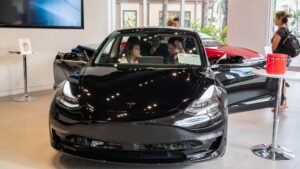**Unlocking the Future: Hawaii’s Surprising Shift to Electric Vehicles**
**Introduction:**
As the world navigates towards a more sustainable future, the shift towards electric vehicles (EVs) has been a pivotal point of conversation. While adoption rates across the United States have been slower than anticipated, Hawaii has emerged as a surprising leader in this movement. In this article, we will delve into the unique factors driving Hawaii’s embrace of EVs and what sets it apart from other states.
**Hawaii’s Rise in EV Adoption:**
Amidst the pristine landscapes and vibrant culture, Hawaii has seen a remarkable climb in EV adoption. Ranking fifth in overall EV adoption at 11.9% of new retail vehicles sold through February, the state also holds the third position in J.D. Power’s “EV Adoption Score.” This rating takes into account various factors such as market dynamics, consumer preferences, and the availability of EVs.
According to Elizabeth Krear, Vice President of the electric vehicle practice at J.D. Power, the key to adoption lies in the availability of EV models that cater to consumer needs. While California boasts a higher quantity of EVs, Hawaii’s 33% adoption rate showcases the demand for viable EV options. What sets Hawaii apart is its top position for EV adoption despite not being part of the California Air Resources Board’s Zero-Emission Vehicle program.
**The Hawaii Factor:**
So, what drives Hawaiians to choose EVs? Ivan Drury, Director of Insights at Edmunds, points to several factors including high fuel costs, the availability of renewable energy for charging, and a strong sense of environmental responsibility ingrained in Hawaii’s culture. With hybrid models already popular in the state, the transition to EVs has been seamless.
Moreover, concerns about road trips, a common hurdle in EV adoption in mainland states, are negligible in Hawaii due to its island geography. The high prices of gasoline, averaging $4.72 per gallon, have also played a significant role in nudging consumers towards EVs.
**Leading the Charge:**
The top-selling EVs in Hawaii include models like the Tesla Model Y, Tesla Model 3, and Ford F-150 Lightning. Owners like Scott Sageman, who relishes the freedom from gas purchases, highlight the satisfaction derived from owning an EV in Hawaii’s unique setting.
While interest in EVs continues to grow, they currently account for only around 2% of sales in Aloha Kia’s dealerships. However, with the introduction of new models like the Kia EV9 SUV, the trend is expected to climb steadily. The affordability factor also comes into play, with the Niro being the best-selling EV at Kia dealerships starting at approximately $36,000.
**Challenges Ahead:**
Despite Hawaii’s strides in EV adoption, challenges like charging infrastructure, affordability, and limited vehicle choices persist. A Gallup poll found a decline in the willingness of U.S. adults to consider buying an EV, citing concerns over range anxiety and high costs. As Hawaii grapples with these obstacles, efforts are being made to enhance accessibility and affordability for a broader consumer base.
In conclusion, Hawaii’s remarkable journey towards electric vehicle adoption exemplifies a sustainable future driven by conscious choices and environmental stewardship. As the EV landscape evolves, Hawaii stands out as a promising model for embracing clean transportation solutions. Stay tuned to Extreme Investor Network for more insights on the latest trends in the business world.

